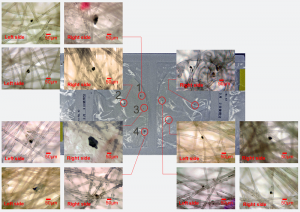Internal exposure dose from radiocesium-contaminated cedar pollen negligible compared to fugitive dust Avoiding fugitive dust reduces internal exposure

In the spring of 2012, a year after the Fukushima Daiichi nuclear disaster, there was general concern that inhalation of radiocesium-contaminated Japanese cedar pollen may have caused the general population internal exposure to radioactive material.

© 2014 Shogo Higaki.
A composite image of the mask worn by a subject on the first day of the first week (March 2 to 3, 2012), its radiocesium distribution, and its microscope image.
To determine if pollen had been contaminated through uptake of radiocesium by Japanese cedar and was therefore contributing to inhaled doses, Research Associate Shogo Higaki at the University of Tokyo Radioisotope Center measured radiocesium and Japanese cedar pollen adhered to nonwoven fabric masks worn by 68 subjects residing in eastern Japan, including Fukushima prefecture, for 8 weeks in the spring of 2012 (19 February 2012 to 14 April 2012). It was discovered that the principle source of radiocesium that might bring about internal exposure was not cedar pollen but fugitive dust (small particles without a clear point of origin).
The maximum cumulative Cesium-137(137Cs) and Cesium-134(134Cs) radioactivities on masks worn by an individual were 21 ± 0.36 Bq and 15 ± 0.22 Bq, respectively, and the estimated effective dose during the 8 week was 0.494 µSv. Based on these values, the internal exposure over one year was estimated at 3.2 µSv. While this value is 1/310th of the official internal exposure limit of 1 mSv/year, this dose can be further reduced by preventing inhalation of fugitive dust.
The radiocesium released into the environment as a result of the Fukushima Daiichi nuclear disaster consists of two relatively long-lived isotopes. Cesium-137 has a half-life of 30 years (it takes roughly 30 years to reduce in quantity to half its original amount as it breaks down, emitting radiation in the process), while cesium-134 has a half-life of two years.
Press release (Japanese)
Paper
Shogo Higaki*, Hideharu Shirai, Masahiro Hirota, Eisuke Takeda, Yukiko Yano, Akira Shibata, Yoshitaka Mishima, Hiromi Yamamoto and Kiyoshi Miyazawa,
“Quantitation of Japanese cedar pollen and radiocesium adhered to nonwoven fabric masks worn by the general population”,
Health Physics August 2014 – Volume 107 – Issue 2 – p 117-134, doi: 10.1097/HP.0000000000000078.
Article link
Links
Radioisotope Center (Japanese)
Research Associate Shogo Higaki’s Webpage (Japanese)







